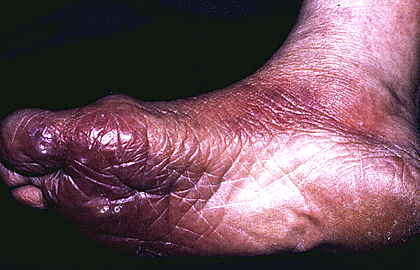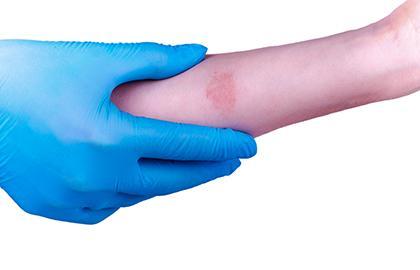**If you find a sign of Lyme disease on your skin, see your doctor right away. When caught early and treated, Lyme disease can be cured with antibiotics and most people recover fully.
Lyme disease is caused by a bite from a black-legged tick. If you are bitten by this tick and develop Lyme disease, you may see a bull’s-eye rash. It’s a common sign of Lyme disease, but it’s not the only sign.
Lyme disease occurs in stages. Here’s what you may see on your skin during each stage.
Stage 1: Quickly expanding rash
After being bitten by a black-legged tick, a quickly growing rash can appear. This is the earliest stage of Lyme disease, known as stage 1.
Most people who develop a rash, get it within days or weeks of being bitten by a tick.
Where you see the rash: If you develop a rash, it appears near (or where) the tick bit you. For most people, that means the back, groin, armpit, or a lower leg. However, a tick can bite you anywhere.
What the rash can look like: You may see a spot or bump on the skin, which is the bite mark. Around or near the bite mark, a rash develops. Some people see the bull’s-eye rash (shown below). You can also have one of the other rashes shown here.
 Early rash caused by Lyme disease: Notice the bite mark in the center of this early rash, which will expand quickly. |  Bull’s-eye rash on woman’s upper arm: This is another early sign of Lyme disease. | |
 Lyme disease rash with lighter color on the outside: This rash has expanded, but you can still see the bite mark in the center. |  Rash from Lyme disease has begun to clear: As the rash begins to clear, the redness fades. |
If you develop a rash during this stage, you may notice that it:
- Feels smooth and warm to the touch
- Causes a burning sensation
- Itches or feels painful
- Has an outer edge that feels scaly or crusty
When the rash and symptoms begin: According to the Centers for Disease Control and Prevention (CDC), the rash begins 3 to 30 days after the tick bites you.
About 50% of people who have Lyme disease develop flu-like symptoms, which include:
- Fever
- Chills
- Muscle aches
- Joint pain
- Headache
- Swollen lymph nodes near the bite
- Fatigue
Symptoms tend to begin before the rash appears.
Stage 2: Small, oval rashes or a reddish lump
When a tick that causes Lyme disease bites you, it infects you with bacteria. Without treatment, the bacteria can spread to other areas of your body. If it spreads, you have stage 2 Lyme disease.
During this stage, you may see small, oval rashes on your skin. Some people develop a bluish-red lump.
Where you see these signs: Because the infection has spread, small rashes can appear anywhere on your skin, except for your palms and soles. Most rashes appear on the arms, legs, and face.

Some people develop a lump, which your doctor may refer to as borrelial (bore-eh-lee-ul) lymphocytoma (lim-foe-sigh-toe-ma). In children, this lump tends to appear on an earlobe. Adults often see a raised growth form around a nipple.
What you may see on your skin: The rashes that appear during stage 2 differ from the rash that can appear in stage 1. In stage 2, the rashes stay the same size rather than grow larger.
When the rashes, lump, and symptoms begin: About 30 to 45 days after the tick bites you, you may notice rashes or a lump. These can also take longer to appear, sometimes 6 months or more.
Some people develop symptoms, which make them feel ill, including:
- Fever
- Arthritis that comes and goes
- Headaches
- Muscles aches, especially neck stiffness
- Numbness or pain
- Shortness of breath and dizzy spells
- Bell’s palsy, which causes one half of the face to droop
- Heart problems, such as chest pains or an irregular heartbeat
How long do the rashes, lump, and symptoms last: If treated with antibiotics, signs and symptoms tend to clear within 3 weeks. Without treatment, the symptoms tend to come and go indefinitely, and some people develop stage 3 Lyme disease.
Stage 3: Changing skin
In stage 3, few signs of Lyme disease appear on the skin. Most problems occur in the heart and nervous system, and these can be serious.
Where you see signs on your skin: If you were in Europe when bit by a tick, you may see changes to your skin in this late stage. These changes usually appear on a hand or foot. Some people develop this change on both of their hands or feet. It can also occur on a knee, elbow, or elsewhere.
What the skin looks like: The skin begins to swell, and you may notice some redness. These signs are caused by having a bacterial infection for a long time. The affected skin may also feel sore.

In time, the skin starts to harden and shrink, causing deep lines to form. If you have hair in the area, it tends to fall out. The sweat glands can die, and the skin often becomes so thin that it tears easily. The medical name for this condition is acrodermatitis (ack-rah-derm-ah-tie-tus) chronical atrophicans (ah-trough-eh-cans).
In stage 3, you may also see tumors on your skin. It is believed that the long-term infection and swelling in the lymph nodes can lead to a cancer known as cutaneous B-cell lymphoma.
When you see signs of changing skin and symptoms: These tend to occur months or years after you are bitten by a tick.
In stage 3, a person tends to have many symptoms of illness, which may include:
- Arthritis
- Problems remembering and concentrating
- Nerve pain
- Dementia
- Heart failure
How long the changes last: Even with treatment for Lyme disease, the changes to the skin, tumors, and symptoms tends to be permanent.
Seek medical care early to prevent Lyme disease from progressing
It’s easy to get bit by a tick and not know it. Most people don’t feel a tick on their skin or the bite. Checking your skin for ticks after spending time outdoors can help you find a tick and remove it.
Removing a tick can prevent Lyme disease. A tick must be attached to your skin for at least 36 hours to infect you with the bacteria that cause Lyme disease.
It’s not always possible to find a tick, so it’s important to pay close attention to your skin. If you notice any signs of Lyme disease or develop a rash, get medical care right away. Ticks can cause other serious diseases, such as Rocky Mountain spotted fever.
Additional related articles
Source: American Academy of Dermatology – www.aad.org


